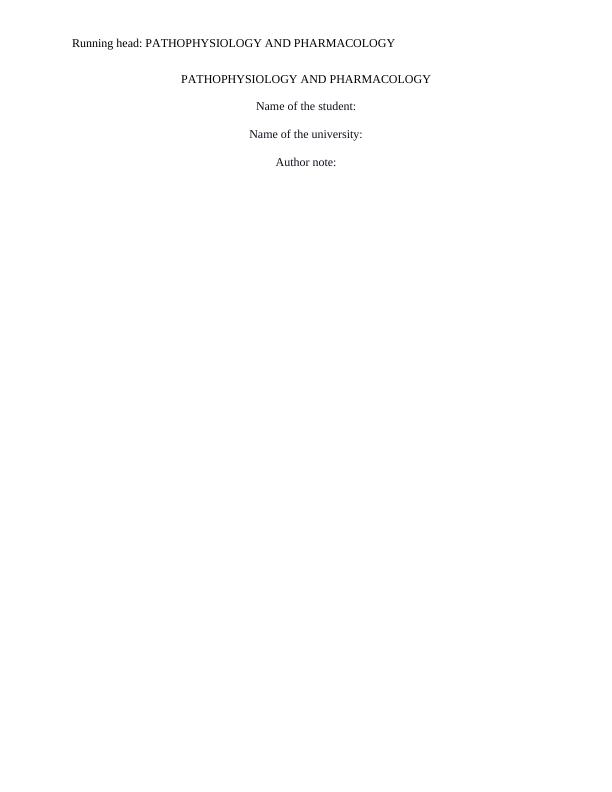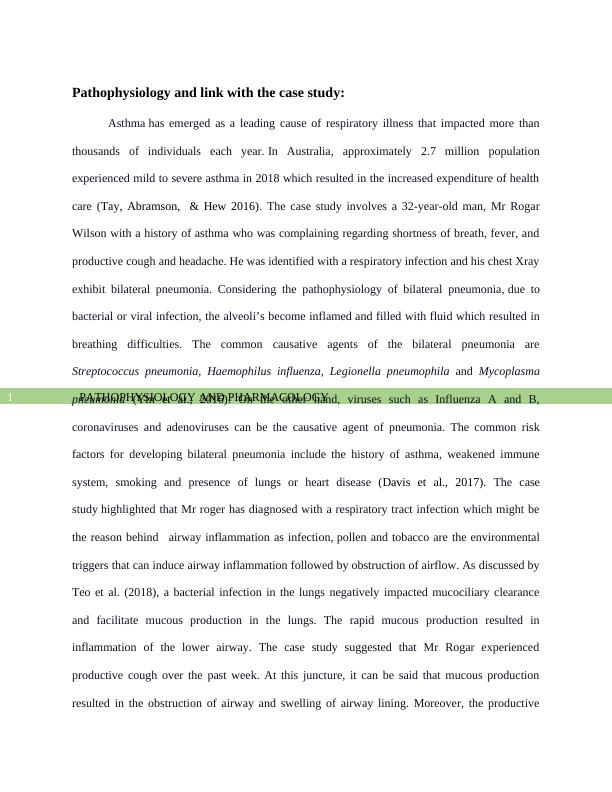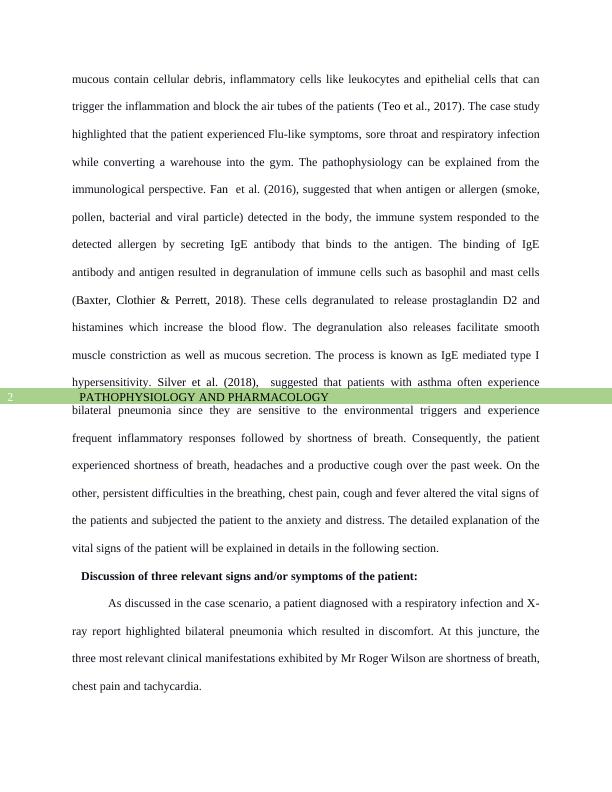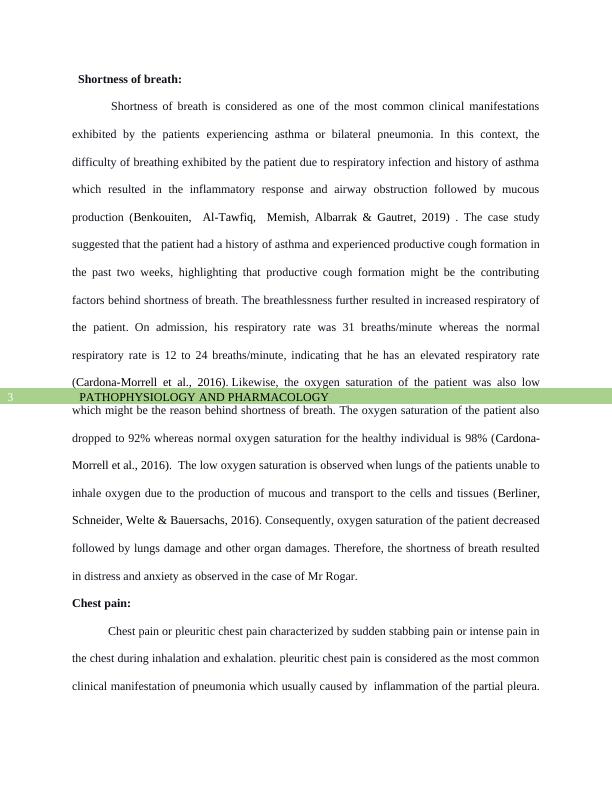ASSIGNMENT ON PATHOPHYSIOLOGY AND PHARMACOLOGY.
Added on 2022-09-14
13 Pages3607 Words16 Views
Running head: PATHOPHYSIOLOGY AND PHARMACOLOGY
PATHOPHYSIOLOGY AND PHARMACOLOGY
Name of the student:
Name of the university:
Author note:
PATHOPHYSIOLOGY AND PHARMACOLOGY
Name of the student:
Name of the university:
Author note:

PATHOPHYSIOLOGY AND PHARMACOLOGY1
Pathophysiology and link with the case study:
Asthma has emerged as a leading cause of respiratory illness that impacted more than
thousands of individuals each year. In Australia, approximately 2.7 million population
experienced mild to severe asthma in 2018 which resulted in the increased expenditure of health
care (Tay, Abramson, & Hew 2016). The case study involves a 32-year-old man, Mr Rogar
Wilson with a history of asthma who was complaining regarding shortness of breath, fever, and
productive cough and headache. He was identified with a respiratory infection and his chest Xray
exhibit bilateral pneumonia. Considering the pathophysiology of bilateral pneumonia, due to
bacterial or viral infection, the alveoli’s become inflamed and filled with fluid which resulted in
breathing difficulties. The common causative agents of the bilateral pneumonia are
Streptococcus pneumonia, Haemophilus influenza, Legionella pneumophila and Mycoplasma
pneumonia (Yin et al., 2016). On the other hand, viruses such as Influenza A and B,
coronaviruses and adenoviruses can be the causative agent of pneumonia. The common risk
factors for developing bilateral pneumonia include the history of asthma, weakened immune
system, smoking and presence of lungs or heart disease (Davis et al., 2017). The case
study highlighted that Mr roger has diagnosed with a respiratory tract infection which might be
the reason behind airway inflammation as infection, pollen and tobacco are the environmental
triggers that can induce airway inflammation followed by obstruction of airflow. As discussed by
Teo et al. (2018), a bacterial infection in the lungs negatively impacted mucociliary clearance
and facilitate mucous production in the lungs. The rapid mucous production resulted in
inflammation of the lower airway. The case study suggested that Mr Rogar experienced
productive cough over the past week. At this juncture, it can be said that mucous production
resulted in the obstruction of airway and swelling of airway lining. Moreover, the productive
Pathophysiology and link with the case study:
Asthma has emerged as a leading cause of respiratory illness that impacted more than
thousands of individuals each year. In Australia, approximately 2.7 million population
experienced mild to severe asthma in 2018 which resulted in the increased expenditure of health
care (Tay, Abramson, & Hew 2016). The case study involves a 32-year-old man, Mr Rogar
Wilson with a history of asthma who was complaining regarding shortness of breath, fever, and
productive cough and headache. He was identified with a respiratory infection and his chest Xray
exhibit bilateral pneumonia. Considering the pathophysiology of bilateral pneumonia, due to
bacterial or viral infection, the alveoli’s become inflamed and filled with fluid which resulted in
breathing difficulties. The common causative agents of the bilateral pneumonia are
Streptococcus pneumonia, Haemophilus influenza, Legionella pneumophila and Mycoplasma
pneumonia (Yin et al., 2016). On the other hand, viruses such as Influenza A and B,
coronaviruses and adenoviruses can be the causative agent of pneumonia. The common risk
factors for developing bilateral pneumonia include the history of asthma, weakened immune
system, smoking and presence of lungs or heart disease (Davis et al., 2017). The case
study highlighted that Mr roger has diagnosed with a respiratory tract infection which might be
the reason behind airway inflammation as infection, pollen and tobacco are the environmental
triggers that can induce airway inflammation followed by obstruction of airflow. As discussed by
Teo et al. (2018), a bacterial infection in the lungs negatively impacted mucociliary clearance
and facilitate mucous production in the lungs. The rapid mucous production resulted in
inflammation of the lower airway. The case study suggested that Mr Rogar experienced
productive cough over the past week. At this juncture, it can be said that mucous production
resulted in the obstruction of airway and swelling of airway lining. Moreover, the productive

PATHOPHYSIOLOGY AND PHARMACOLOGY2
mucous contain cellular debris, inflammatory cells like leukocytes and epithelial cells that can
trigger the inflammation and block the air tubes of the patients (Teo et al., 2017). The case study
highlighted that the patient experienced Flu-like symptoms, sore throat and respiratory infection
while converting a warehouse into the gym. The pathophysiology can be explained from the
immunological perspective. Fan et al. (2016), suggested that when antigen or allergen (smoke,
pollen, bacterial and viral particle) detected in the body, the immune system responded to the
detected allergen by secreting IgE antibody that binds to the antigen. The binding of IgE
antibody and antigen resulted in degranulation of immune cells such as basophil and mast cells
(Baxter, Clothier & Perrett, 2018). These cells degranulated to release prostaglandin D2 and
histamines which increase the blood flow. The degranulation also releases facilitate smooth
muscle constriction as well as mucous secretion. The process is known as IgE mediated type I
hypersensitivity. Silver et al. (2018), suggested that patients with asthma often experience
bilateral pneumonia since they are sensitive to the environmental triggers and experience
frequent inflammatory responses followed by shortness of breath. Consequently, the patient
experienced shortness of breath, headaches and a productive cough over the past week. On the
other, persistent difficulties in the breathing, chest pain, cough and fever altered the vital signs of
the patients and subjected the patient to the anxiety and distress. The detailed explanation of the
vital signs of the patient will be explained in details in the following section.
Discussion of three relevant signs and/or symptoms of the patient:
As discussed in the case scenario, a patient diagnosed with a respiratory infection and X-
ray report highlighted bilateral pneumonia which resulted in discomfort. At this juncture, the
three most relevant clinical manifestations exhibited by Mr Roger Wilson are shortness of breath,
chest pain and tachycardia.
mucous contain cellular debris, inflammatory cells like leukocytes and epithelial cells that can
trigger the inflammation and block the air tubes of the patients (Teo et al., 2017). The case study
highlighted that the patient experienced Flu-like symptoms, sore throat and respiratory infection
while converting a warehouse into the gym. The pathophysiology can be explained from the
immunological perspective. Fan et al. (2016), suggested that when antigen or allergen (smoke,
pollen, bacterial and viral particle) detected in the body, the immune system responded to the
detected allergen by secreting IgE antibody that binds to the antigen. The binding of IgE
antibody and antigen resulted in degranulation of immune cells such as basophil and mast cells
(Baxter, Clothier & Perrett, 2018). These cells degranulated to release prostaglandin D2 and
histamines which increase the blood flow. The degranulation also releases facilitate smooth
muscle constriction as well as mucous secretion. The process is known as IgE mediated type I
hypersensitivity. Silver et al. (2018), suggested that patients with asthma often experience
bilateral pneumonia since they are sensitive to the environmental triggers and experience
frequent inflammatory responses followed by shortness of breath. Consequently, the patient
experienced shortness of breath, headaches and a productive cough over the past week. On the
other, persistent difficulties in the breathing, chest pain, cough and fever altered the vital signs of
the patients and subjected the patient to the anxiety and distress. The detailed explanation of the
vital signs of the patient will be explained in details in the following section.
Discussion of three relevant signs and/or symptoms of the patient:
As discussed in the case scenario, a patient diagnosed with a respiratory infection and X-
ray report highlighted bilateral pneumonia which resulted in discomfort. At this juncture, the
three most relevant clinical manifestations exhibited by Mr Roger Wilson are shortness of breath,
chest pain and tachycardia.

PATHOPHYSIOLOGY AND PHARMACOLOGY3
Shortness of breath:
Shortness of breath is considered as one of the most common clinical manifestations
exhibited by the patients experiencing asthma or bilateral pneumonia. In this context, the
difficulty of breathing exhibited by the patient due to respiratory infection and history of asthma
which resulted in the inflammatory response and airway obstruction followed by mucous
production (Benkouiten, Al-Tawfiq, Memish, Albarrak & Gautret, 2019) . The case study
suggested that the patient had a history of asthma and experienced productive cough formation in
the past two weeks, highlighting that productive cough formation might be the contributing
factors behind shortness of breath. The breathlessness further resulted in increased respiratory of
the patient. On admission, his respiratory rate was 31 breaths/minute whereas the normal
respiratory rate is 12 to 24 breaths/minute, indicating that he has an elevated respiratory rate
(Cardona-Morrell et al., 2016). Likewise, the oxygen saturation of the patient was also low
which might be the reason behind shortness of breath. The oxygen saturation of the patient also
dropped to 92% whereas normal oxygen saturation for the healthy individual is 98% (Cardona-
Morrell et al., 2016). The low oxygen saturation is observed when lungs of the patients unable to
inhale oxygen due to the production of mucous and transport to the cells and tissues (Berliner,
Schneider, Welte & Bauersachs, 2016). Consequently, oxygen saturation of the patient decreased
followed by lungs damage and other organ damages. Therefore, the shortness of breath resulted
in distress and anxiety as observed in the case of Mr Rogar.
Chest pain:
Chest pain or pleuritic chest pain characterized by sudden stabbing pain or intense pain in
the chest during inhalation and exhalation. pleuritic chest pain is considered as the most common
clinical manifestation of pneumonia which usually caused by inflammation of the partial pleura.
Shortness of breath:
Shortness of breath is considered as one of the most common clinical manifestations
exhibited by the patients experiencing asthma or bilateral pneumonia. In this context, the
difficulty of breathing exhibited by the patient due to respiratory infection and history of asthma
which resulted in the inflammatory response and airway obstruction followed by mucous
production (Benkouiten, Al-Tawfiq, Memish, Albarrak & Gautret, 2019) . The case study
suggested that the patient had a history of asthma and experienced productive cough formation in
the past two weeks, highlighting that productive cough formation might be the contributing
factors behind shortness of breath. The breathlessness further resulted in increased respiratory of
the patient. On admission, his respiratory rate was 31 breaths/minute whereas the normal
respiratory rate is 12 to 24 breaths/minute, indicating that he has an elevated respiratory rate
(Cardona-Morrell et al., 2016). Likewise, the oxygen saturation of the patient was also low
which might be the reason behind shortness of breath. The oxygen saturation of the patient also
dropped to 92% whereas normal oxygen saturation for the healthy individual is 98% (Cardona-
Morrell et al., 2016). The low oxygen saturation is observed when lungs of the patients unable to
inhale oxygen due to the production of mucous and transport to the cells and tissues (Berliner,
Schneider, Welte & Bauersachs, 2016). Consequently, oxygen saturation of the patient decreased
followed by lungs damage and other organ damages. Therefore, the shortness of breath resulted
in distress and anxiety as observed in the case of Mr Rogar.
Chest pain:
Chest pain or pleuritic chest pain characterized by sudden stabbing pain or intense pain in
the chest during inhalation and exhalation. pleuritic chest pain is considered as the most common
clinical manifestation of pneumonia which usually caused by inflammation of the partial pleura.

End of preview
Want to access all the pages? Upload your documents or become a member.
Related Documents
Pharmacology and Pathophysiologylg...
|12
|3125
|20
Asthma Exacerbations: Pathogenesis, Prevention, and Treatment | Case Study Analysislg...
|7
|2096
|11
Body Integrity Assignment PDFlg...
|5
|1450
|42
RESPIRATORY SYSTEM CASE STUDY 2022lg...
|10
|2709
|12
Pathophysiology And Pharmacology - Case Studylg...
|16
|4661
|17
Type of Asthma: Allergic Asthma in a Six-Year-Old Childlg...
|5
|1500
|186
